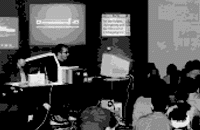
Nick PHILIP'S Selected Works
September 16-27, 1998Gallery D
The young San Francisco digital designer Nick PHILIP was invited to show his work and present four workshops at the ICC. PHILIP, who began working in this field in London about a decade ago, initially attracted attention for punk-influenced, in-your-face design, particularly of t-shirts. His t-shirts, his early graphic designs dating from after he moved to San Francisco and began working in digital design, and his work on the early issues of the magazine Wired--work in the heyday of digital design, which caught the beat of the personal computer boom--put this designer in the limelight.
It was characteristic of his work in the first half of the 1990s that, while groping for a digital design methodology, he retained an ironical perspective on the burgeoning digital culture. Social criticism, a rare attitude in a designer, can be clearly read in his work. In its early phases, Wired, which had an underground magazine image, shared that critical stance. (The impression it gives now is somewhat contrary.) Thus, PHILIP's origins are different from those of commercial digital designers.
PHILIP was one of the designers who typified the West Coast rave scene, but he subsequently shifted to a style that might be described as a revival of the late 1960s psychedelic movement. He worked in a wide range of fields--including music as well as graphic design--while addressing the influence of digital technology: not only its superficial, mass production aspects but its impact on the human spiritual world. That work came together in his [Radical Beauty] CD-ROM released in 1997, which revealed his intensifying interest in the human body. [The End of Man] series, his latest work (part of which was included in the ICC exhibition), focuses on the direct relationship between technology and the body and uses digital methods to give a sense of organic images.
The new [nowhere.com] installation was a particularly noteworthy part of the exhibition. Emerging from his interest in where the Internet is heading, this work addresses the Internet society of today with biting irony.
"nowhere.com" is a fictitious Internet domain name. Domain names are the addresses of the people participating in the Internet and are centrally controlled so that they are never duplicated. Some people, however, use fictitious, nonexistent domain names to send e-mail messages while concealing their own addresses (i.e., their identities). The classic fictitious domain name is "nowhere.com."
Almost all the e-mail sent from nowhere.com is junk mail or spam. Invitations to invest in dubious businesses, abuse, harassment--mail that symbolizes the dirty underside of the Internet pours out from nowhere.com, day and night.
In this installation, PHILIP hacks mail from nowhere.com in real time to send it spewing forth from 12 fax machines connected to modems. Whenever a piece of e-mail is sent from a nowhere.com domain anywhere in the world, the computer randomly fires up a modem and dials up a fax machine. The 12 fax machines are kept busy printing out a torrent of such junk mail. Each was loaded with a 100-meter roll of paper and had a large trash can set beneath it. The fax paper was already overflowing from the trash cans on the first day of the exhibition. By the last day, the space around them was buried in mountains of paper.
We cannot visualize or perceive a huge body of digital data flowing over the networks in a physical form in real time. But PHILIP's installation provides a vivid visualization of part of that flow, the dark side of electronic mail and the Internet--its multi-directionality, simultaneity, anonymity, and simplicity. The mutter of dialing sounds, the screech of fax warble, the 12 faxes spewing forth mountains of junk mail: this installation vividly shows one aspect of the network society, today and in the future.
PHILIP's four workshops included two lectures on his work, a concert with DJ's, to which he invited MUNETOMO Ryuji and GEO as guests, and, finally, a class in PhotoShop 5.0 by PHILIP and his assistant Jeff TAYLOR. Most of the participants in it were design students and other young people, for whom PHILIP's remarks addressing concepts, not technique, was a glimpse of something new, since the digital design world in Japan tends to be focused exclusively on technical maters.
As one would expect of an artist with a grounding in street culture, PHILIP brought a relaxed atmosphere to his exhibition and workshops and found many occasions for direct communication with visitors. The events came to a successful close with a sense that both the artist and visitors were on the same wave length--a good model for future ICC events with young artists.
[GOGOTA Hisanori]

 To Contents Menu
To Contents Menu